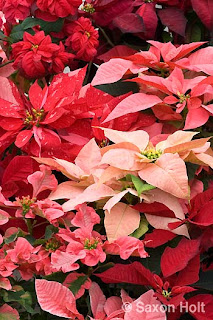Are you a trivia buff? If so, perhaps you'd be interested in knowing a little bit more about the poinsettia plant you buy every Christmas season. This knowledge should really impress your friends and family at the holiday dinner table.
Did you know that the poinsettia's main attraction is not its flowers, but its leaves? The flowers of the plant are the yellow clustered buds in the center. The colored leafy parts are actually bracts or modified leaves.
Red is the most popular color, accounting for roughly tow thirds of all sales nationwide, followed by white, pink, marble and peppermint candy. Poinsettia's also come in a variety of other shades of salmon, apricot, yellow and cream. There are also unusual speckled or marbled varieties like "White Glitter". New varieties are introduced yearly with even more variation in height and colors.
How many poinsettias do you think are sold each year? Would you believe over 5 million! In Canada, Poinsettia's accounted for one third of sales of all flowering potted plants.
Because of the plants dislike of traveling long distances, there are growers of poinsettias in almost every state and in Canada they are in every Providence.
In the wild, the poinsettia can reach heights of 12 feet with leaves measuring six to eight inches across? It is actually a small tropical tree belonging to the Euphorbia plant family. Its botanical name is Euphorbia. A native of southern Mexico, the poinsettia blooms in December and has been used in that country to decorate churches for centuries.
In the 14th to 16th centuries, the Aztecs used the poinsettia leaves to dye fabric for clothing and the sap for medicinal purposes, including to help control fevers. They also considered the red color a symbol of purity, and so poinsettias were traditionally part of religious ceremonies.
Dr. Joel Roberts Poinsett, an amateur botanist and first U.S. ambassador to Mexico, introduced the plant that became known as the poinsettia to this country. He discovered a shrub with brilliantly colored red leaves growing by the side of the road in Taxco,Mexico. In December 1828, he sent cuttings home to his plantation in Greenville, South Carolina.
However, most botanists at that time dismissed the poinsettia as a weed. Fortunately, Poinsett continued to study and breed this plant in his greenhouse, sharing plants with his horticulturist friends. It soon gained acceptance as a holiday plant, despite its very short bloom time. It wasn't until the 1960's that researchers were able to successfully breed plants to bloom more than just a few days.
 |
| Some painted poinsettia's |
True or False? The poinsettia is a poisonous plant. If you answered false, you're correct. The plant has been tested repeatedly and cleared of this charge by the National Poison Center in Atlanta, Georgia, and the American Medical Association. The POINSINDEX Information Service reports that even if a 50 pound child consumed more than 500 poinsettia bracts--the amount tested in scientific experiments--the consequences would not be fatal. Even at this high level, no toxicity was found.
However, this doesn't mean that poinsettia's are meant to be eaten. If ingested, this plant can cause stomach irritation and discomfort. Cats and children also may choke on the fibrous parts, so be sure to keep these plants out of their reach. The sticky white sap also may cause skin irritation for some people.
Do you know the best way to prolong the life of this Christmas plant? Avoid hot or cold drafts, keep the soil moist not soggy, and place in a room with sufficient natural light and temperatures of around 60 to 70 degrees F. Water when the soil begins to dry. Once the leaves begin to wilt, it's too late.
Above all, protect it from exposure to wind or cold on the way home from the garden center. Poinsettia's are highly sensitive to cold temperatures and even a few minutes of exposure to 50 degree or lower temperatures will cause them to wilt. But when care for properly, poinsettias usually will outlast your desire to keep them.









No comments:
Post a Comment